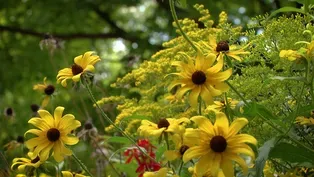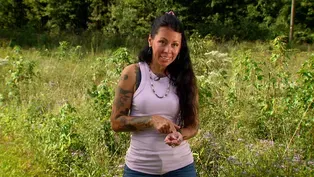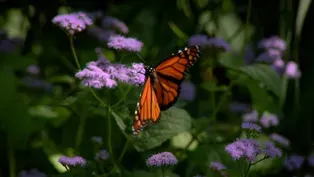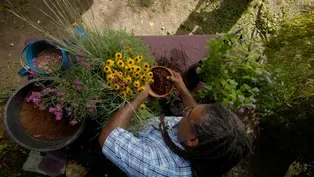Virginia Home Grown
Native Plants for the Landscape
Clip: Season 23 Episode 7 | 6m 19sVideo has Closed Captions
Discover native plants for the home landscape
Lisa Trapp, from Capital Trees, presents a variety native trees, shrubs and perennials suited for use in home landscapes. Featured on VHG episode 2307; September 2023.
Problems with Closed Captions? Closed Captioning Feedback
Problems with Closed Captions? Closed Captioning Feedback
Virginia Home Grown is a local public television program presented by VPM
Virginia Home Grown
Native Plants for the Landscape
Clip: Season 23 Episode 7 | 6m 19sVideo has Closed Captions
Lisa Trapp, from Capital Trees, presents a variety native trees, shrubs and perennials suited for use in home landscapes. Featured on VHG episode 2307; September 2023.
Problems with Closed Captions? Closed Captioning Feedback
How to Watch Virginia Home Grown
Virginia Home Grown is available to stream on pbs.org and the free PBS App, available on iPhone, Apple TV, Android TV, Android smartphones, Amazon Fire TV, Amazon Fire Tablet, Roku, Samsung Smart TV, and Vizio.
Providing Support for PBS.org
Learn Moreabout PBS online sponsorshipSo, Lisa, you've got quite an array of different plants here.
So, what do we have?
>>Yeah, so, I've brought in a couple of different trees, a couple of different shrubs, and some different perennials as well, just to kinda highlight some of my favorites, from down at the Low Line.
>>Okay.
>>So, the first one I would love to talk to you about today is our river birch.
>>Yes.
>>This one I love.
>>It loves water, doesn't it?
(chuckles) >>It does, yeah.
It's not particularly happy with the cutting I made earlier today.
But it really does have these beautiful little leaves on there, and it gets this wonderful kind of shreddy bark to it.
>>Yes.
>>And it has a wonderful fall color.
>>Yes.
>>It really does quite well, actually, in a range of moist and dry areas.
And so, it really is kind of hardy of a plant.
But the other reason I love it is that it does provide resources to passing insects.
It also is sometimes a host plant for your saturniidaes, your mouthless moths, your luna moths, your polyphemus moths, your cecropias.
In fact, I was lucky enough to see a luna moth this year at the Low Line.
>>How fun!
>>So really, these do have tremendous wildlife value, and they are beautiful to look at in the landscape.
>>Checks off two boxes.
>>Yes, absolutely.
>>Pretty tree that works in the landscape.
So, well, here's one very few people know about.
>>Yes.
>>And it's a favorite of mine.
And I'm gonna put it upside down.
>>Absolutely.
This is also a favorite of mine as well.
This is our hop-hornbeam.
>>Mm-hm.
>>It is just the coolest plant.
I mean, it's got these wonderful little leaves on it.
The bark is really shreddy, and kind of really texturally >>Yes.
>>interesting to look at.
But the favorite part of this whole thing is these wonderful little seed pods.
>>Yes.
>>They get its name because they look like little hops, >>Mm-hm.
>>which I think is the coolest thing!
But on top of that, they also have these lovely little catkins on the end.
>>Mm-hm.
>>So they actually are a wonderful food source for seed-eating songbirds.
They're wonderful for insects as well.
And, really, once their leaves fall in the winter, they have lovely winter interest, 'cause these seed pods stick around.
>>Yes, they do.
>>And I think, you know, a lot of native plants, we always think that they don't look like anything in the winter, but this is just one of the coolest things to see in the landscape.
So, I love this one, yeah.
>>I do too.
A soft snow on this plant in the winter is very striking.
>>Oh yes.
It's one of my favorites.
>>Yes, I do.
And as you can see, it has lovely green leaves too.
>>Oh, yes, still.
>>Yeah.
>>Still green right now.
(Lisa chuckles) >>Okay.
Now here's one that many people just absolutely love.
>>Mm-hm.
>>And it's a Virginia favorite, and I'll just tuck it over there, yes.
>>Perfect, yes.
This is our sweet bay magnolia.
>>Uh-huh.
>>I wanted to highlight this one because it does have the potential to stay evergreen.
If it gets a little colder, it can drop its leaves.
>>Yeah.
>>But if you are looking for something that might have a little bit more longevity in the winter, >>Yeah.
>>this is a wonderful tree for that.
And it's got these really kinda cool, red seed pods also.
>>Yeah.
>>I'm all about a seed pod.
>>Yes.
(chuckles) >>So, really, these are great, again, great food for songbirds, all sorts of things.
>>Yes.
>>If it's got a fun seed pod, it's probably feeding something.
>>Yes.
And this one's got a nice glossy leaf, which adds >>Mm-hm.
>>a different texture to the landscape.
>>Absolutely.
>>But it does need moisture.
>>Yes, they are a little bit >>Yes.
>>more persnickety, I think, than some of the other trees >>Yes.
>>that we brought today.
>>This doesn't adapt to dry.
That's experience talking.
I tried.
(Lisa chuckles) I like it.
So, anyway.
Well, some shrubs that you have to share.
>>Yeah.
Absolutely.
>>Let's move on to those.
You wanna move on to the hollies together?
>>Sure, let's do that.
So I did bring in two.
>>I'm gonna put this one up.
Well, no, I guess that's better.
>>Yeah, I did bring in two today.
I tried to grab a couple with some berries on it.
>>Yeah.
>>We have some winterberry here, with the red berries, and then inkberry, with the smallish blue-gray berries on them.
They are in the holly family, so they do need a male plant in order to set fruit.
>>Yes.
>>But the inkberry remains evergreen throughout the winter.
>>Yes.
>>It's a wonderful food source, again, for fruit-eating mammals, or birds.
And then, the winterberry, although it's deciduous, these berries are tremendous.
>>Oh, they're beautiful.
>>And I think they feed over 48 different species of songbird.
>>Mm-hm.
>>So, really, if you love birds, especially cedar waxwing, these are the ones you're gonna wanna have.
>>Exactly, and from an aesthetic part, >>Mm-hm.
>>these berries stay on through Christmas, so you can cut them and put 'em in arrangements.
>>Yes, the winterberry, if you will, yeah.
(chuckling) >>Yeah, without the thorns.
Yes.
>>Yes.
>>It's a great plant, though, and I really love 'em.
You can get 'em in different cultivars, different heights >>Yes.
>>to suit your needs.
>>These are, in fact, cultivars.
Because they did come from the Low Line, these are a dwarf variety.
>>Excellent, excellent.
So they stay within the landscape confines.
>>Yes, so they're a little bit >>Yes.
>>more compact down there.
>>Yeah.
What else do you have to share?
>>We have a couple, oh, I also have, actually, I guess, our arrowwood viburnum.
This is a little bit of a different shrub.
Again, more moisture-loving, didn't love >>Being in your car.
>>being cut this morning and sitting in the car.
But I will do my best.
It has, again, this really tremendous leaf.
And I brought this one in because it does have a very straight growth.
>>Yes.
>>And so, it kind of serves a different purpose, if you're looking to kind of block, or provide a barricade through planting, >>Mm-hm.
>>like a hedge or, >>It's a great screen.
Yeah.
>>yeah, thank you, a screen.
But this also has tremendous wildlife value.
>>Yeah.
>>I mean, it's really one of those that feeds the insects, and then feeds the birds that eat the insects, >>Yes.
>>and feeds the birds that eat the fruit.
And it has a beautiful white flower in the spring.
>>Yes.
>>And then these tremendous blue-purple berries in the fall.
>>They're gorgeous.
>>And it also gets really lovely yellow fall coloration to it.
>>Mm-hm.
>>So, though it does drop its leaves, the sticks are nice and straight, and I think the winter interest on this one is really wonderful as well.
>>That's the reason it's called arrowwood.
>>Yes, absolutely.
>>Yes.
>>Used to make arrows, yes.
>>So we have one minute left.
>>Okay.
>>What would you like to talk about?
>>Well, I will go ahead and highlight this one, I think, might be a good one, just because we have not really talked about stuff for full sun, really dry space.
>>Really, yes.
>>And, or, I guess, I think I've heard recently, it does very well in really moist as well.
So, one or the other.
>>Ooh.
>>But I would love to know if that's true.
>>Me too, I've only grown, this is rattlesnake master, >>Yes.
>>and I've only grown it in harsh dry spots.
>>Dry spots.
So, yes, correct.
We have rattlesnake master here.
Yuccifolium is the species name.
So, like yucca.
>>Like yucca, uh-huh.
>>And it is planted in full sun.
But really, one of the things that it does well is the flower itself is not particularly bright and showy, but it is a powerhouse for pollinators.
>>Oh my gracious.
>>So, and it gets really tall.
>>Mm-hm.
>>So I know I'm not very tall, but it is taller than me.
(Peggy chuckles) And it really is kind of amazing to see the wasps, and the bees, and all the little things that are kind of flocking to it in the spring, >>Yes.
>>and all through the summer.
And then it does have this wonderful seed head as well, that sticks around throughout the winter.
>>Great winter interest.
>>Yeah.
>>And a great plant that people need to grow more in their gardens.
>>Oh, I totally agree.
>>Lisa, thank you for bringing these in.
I appreciate it.
I appreciate you sharing your knowledge.
>>Absolutely.
Video has Closed Captions
Learn how native plants feed wildlife to create healthy ecosystems! (26m 46s)
Video has Closed Captions
Fall wildflower seeds bring early spring color (2m 19s)
Video has Closed Captions
Remove lawn to restore beneficial plant communities (8m 49s)
Video has Closed Captions
Discover native plants to feed people and wildlife (7m 49s)
Providing Support for PBS.org
Learn Moreabout PBS online sponsorshipVirginia Home Grown is a local public television program presented by VPM

















